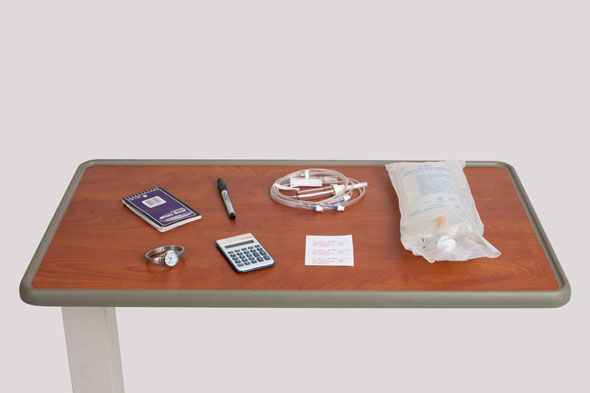Managing Intravenous Fluid Therapy
Select a Skill:
- » Regulating an Intravenous Infusion
- » Using an Infusion Pump
- » Changing Intravenous Tubing and Fluids
- » Changing Intravenous Dressings
Take the Review Test:

Safety
- Observe the Six Rights of Medication Administration when initiating and regulating IV fluids.
- Be aware that changes in patient position, flexion of the IV site extremity, and occlusion of the IV device affect infusion rates.
- Be aware that vasospasm, venous trauma, and manipulation of the device also affect infusion rates.
- To achieve the best therapeutic outcome with the fewest complications, the IV system and flow rate must be assessed regularly according to agency policy.
- Use of a volume-control device can prevent accidental fluid-volume bolus when administering fluids to neonates, very young children, and older adults.
Equipment
(Roll cursor over items to see labels)

Watch with second hand
Calculator
Paper and pen
Label for IV solution
IV administration set (tubing with drip chamber)
1-L IV fluids
Delegation
The skill of regulating IV flow rate may not be delegated to nursing assistive personnel (NAP). Delegation to licensed practical nurses (LPNs) varies according to each state’s nurse practice act. Be sure to inform NAP of the following:
- Instruct NAP to inform you when less than 100 mL remain in the fluid container.
- Instruct NAP to report any patient complaints regarding the intravenous infusion, including pain, burning, bleeding, or swelling at the insertion site.
Preparation
- Review the health care provider’s orders for accuracy and completeness: Check the patient’s name and the solution type, volume, additives, infusion rate, and duration of IV therapy.
- Follow the Six Rights of Medication Administration.
- Be aware that it is common for health care providers to write abbreviated IV orders, such as “D5W with 20 mEq KCl/L 125 mL/hr continuous.” This order indicates that the IV must be maintained at this rate indefinitely, until a subsequent order changes the IV prescription or discontinues it.
- Read the label on the infusion set to determine the drop factor.
- Assess the patient’s knowledge of the effect of IV site position on flow rate.
- Perform hand hygiene. Assess the IV site for signs of infiltration or phlebitis, such as pain, swelling, redness, pallor, or increased warmth.
- Observe for the patency of the IV tubing and venous access device (VAD).
- Identify the patient’s risk for fluid and electrolyte imbalance, considering the type of IV fluid and any history of cardiac or renal disease. Neonates are at a greater risk of fluid or electrolyte imbalance.
Follow-up
- Monitor the IV infusion at least every hour, noting the volume of the IV fluid infused and the rate.
- Observe the patient for signs of electrolyte imbalance and fluid volume excess or deficit.
- Evaluate the patient for signs of IV-related complications, such as infiltration, phlebitis, occluded venous access device (VAD), and obstructed infusion tubing.
- At the change of shift or when leaving on break, report the flow rate and the fluid volume remaining in the infusion to the nurse in charge or to the next nurse assigned to care for the patient.
Documentation
- Record the infusion rate according to agency policy.
- Record the appearance of the IV insertion site as often as specified by agency policy.
Review Questions
1. Which instruction to nursing assistive personnel (NAP) reflects the nurse’s correct understanding of the NAP’s role in caring for a patient receiving intravenous (IV) fluids by gravity drip?
 “Assess the IV site frequently for signs of inflammation.”
“Assess the IV site frequently for signs of inflammation.” “Be sure not to obscure the insertion site with the dressing.”
“Be sure not to obscure the insertion site with the dressing.” “Let me know when you notice that the IV bag contains less than 100 mL.”
“Let me know when you notice that the IV bag contains less than 100 mL.” “Tell the patient to notify me if the IV site is painful, swollen, or red.”
“Tell the patient to notify me if the IV site is painful, swollen, or red.”
2. The provider has ordered that a patient be given 1000 mL of IV normal saline to run over 12 hours. What is the first step in the calculation of the rate of infusion?
 Calculate the hourly volume of normal saline the patient should receive.
Calculate the hourly volume of normal saline the patient should receive. Determine the drop factor of the tubing that will be used for the infusion.
Determine the drop factor of the tubing that will be used for the infusion. Calculate the drops per minute at which the tubing will be regulated.
Calculate the drops per minute at which the tubing will be regulated. Determine the drops per mL that the tubing will deliver.
Determine the drops per mL that the tubing will deliver.
3. The provider orders that a patient be given 1000 mL of IV normal saline to run over 10 hours. The drop factor of the selected tubing is 15. What is the correct rate of infusion in drops per minute?
4. The nurse receives an order to infuse 1000 mL of D5W at 125 mL continuously. Which of the following actions by the nurse indicates correct interpretation of this order?
 Infusing D5W 1000 mL for 8 hours and then discontinuing the infusion
Infusing D5W 1000 mL for 8 hours and then discontinuing the infusion Infusing D5W at a rate of 125 mL/hour for 24 hours and then discontinuing the infusion
Infusing D5W at a rate of 125 mL/hour for 24 hours and then discontinuing the infusion Infusing D5W at a rate of 125 mL/hour until the health care provider changes the order
Infusing D5W at a rate of 125 mL/hour until the health care provider changes the order Calling the health care provider to clarify the order
Calling the health care provider to clarify the order
5. Which action by the nurse helps to ensure patient safety when administering IV fluids by gravity to very young children?
 Using microdrip tubing for the infusion
Using microdrip tubing for the infusion Using macrodrip tubing for the infusion
Using macrodrip tubing for the infusion Using a volume-control device for the infusion
Using a volume-control device for the infusion Not infusing more than 25 mL/hour of IV fluids
Not infusing more than 25 mL/hour of IV fluids
You have completed the Review Questions for this skill. To take the Review again select the Start Over button. To proceed to another skill select from the dropdown menu. Select the Home or Back button to proceed to the next section.

